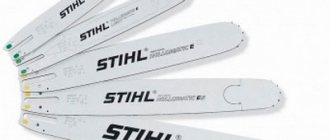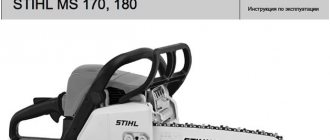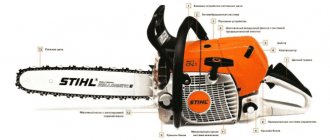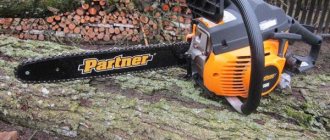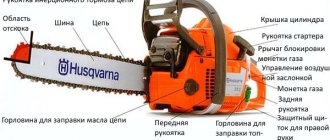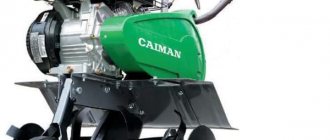Dear visitors, we present to your attention a selection of operating instructions for chainsaws of all brands. This page contains manuals from both well-known (Stihl, Husqvarna) and little-known (Makita, Champion, Hitachi, etc.) chainsaw manufacturers.
All the chainsaws listed below have detailed reviews (purpose, characteristics, disadvantages and advantages, malfunctions and repairs), which are located in the section of our website - Manufacturers.
Stihl instructions
- Stihl MS 170, 180. (our website provides an interesting overview of the Stihl 180 manual for the German chainsaw).
- Stihl MS 171, 181, 211.
- Stihl MS 210, 230, 250.
- Stihl MS 260.
- Stihl MS 270.
- Stihl MS 271, 291.
- Stihl MS 360.
- Stihl MS 361.
- Stihl MS 362.
- Stihl MS 440.
- Stihl MS 461.
- Stihl MS 650, 660.
Tool preparation
A chainsaw is a motorized tool that is powered by a two-stroke internal combustion engine. It cannot run on pure gasoline, so to start it requires preparing a gasoline-oil mixture.
Its proportion is simple: for 1 liter of gasoline, grade no lower than A92 (for expensive imported chainsaws, grade no lower than A95), take 20 grams of special motor oil for chainsaws. In the instructions, this proportion is indicated as 1:50. After mixing fuel and oil in a plastic container, open the filler neck and fill the tank with the combustible mixture.
We advise beginners to be careful not to confuse the fuel neck with the neck for filling the oil that lubricates the chain. On some chainsaw models, they are both located on the same side of the body. They can be distinguished by special markings applied next to the hole. You will see a gas station icon on the fuel filler neck. A drop symbol is applied next to the oil filler neck.
Good chain lubrication is an important condition for the high-quality operation of a chainsaw and the long life of the saw bar. The chainsaw operating instructions recommend using only the manufacturer's branded oil. In addition, it is allowed to fill in high-quality automobile engine oil with a viscosity of W30-W40. We do not recommend using dirty waste and other petroleum substitutes to lubricate the chain.
The mark up to which chain oil is poured into the tank is always located close to the filler neck. When working with a chainsaw, do not forget to periodically glance at it so as not to miss the moment of refilling the tank. In addition to the saw chain, occasionally (once a month) the bar bearing located on its outer end part should be lubricated. Some tires have a special hole there into which a few drops of oil are sprayed using a syringe. Filling the saw with fuel should only be done on a horizontal, hard surface.
8. GENERAL RULES FOR SATTING.
8.1. Before touching the saw chain to the wood, bring the strand stop into contact with the wood.
8.2.Insert the saw chain into the tree smoothly, without excessive force, while simultaneously increasing the engine speed.
8.3. When sawing, do not allow the cutting tool to skew into the cut.
8.4. Do not allow the engine to run for a long time at high speeds when the saw chain is stopped. If the chain gets jammed in the cut, turn the engine to low speed or stop it and release the chain from the jam.
8.5. At the end of the cut and when moving from cut to cut, reduce engine speed to the minimum at which the saw chain stops.
Operating a chainsaw at different times of the year
The two-wheel internal combustion engine that powers the chainsaw requires certain care in different seasons. If work is carried out outdoors in winter and the temperature is below zero, it is very important to warm up the carburetor. This is necessary because the fuel can crystallize at such low temperatures, making the mixture more viscous. Warming up the carburetor allows the saw to adapt to this temperature regime.
It is also worth paying close attention to sudden changes in temperature. If the instrument was stored in the cold, do not suddenly bring it into a warm room, as condensation will immediately form. This accumulation of moisture inside the instrument can cause negative consequences associated with the phenomenon of corrosion.
RUN-IN OF THE NEW CHAIN SAW.
7.1.When working with a new saw, at the beginning of its operation, intensive running-in of all its rubbing surfaces occurs. It is recommended to run in a new saw at idle speed with a short re-throttle until 2-3 tanks of fuel are used up.
7.2. To protect the engine from overloads, during the first 25-30 hours of operation, avoid engine overheating and clutch slipping.
After finishing the break-in, adjust the throttle stroke until it is fully open, if necessary, move the cable into the lever and secure it with a screw, then check the throttle adjustment for minimum stable engine speed at idle.
3. Construction of gasoline-powered saws.
3.1. Gasoline saws “Druzhba”, “Ural”, “Druzhba-Altai” consist of the following main components: engine, clutch, gearbox, sawing apparatus, frame with handles and starter controls.
3.2.The main components of the engine are: crankcase, cylinder, crankshaft assembly with connecting rod, piston, cooling system, power system and ignition system.
3.3. The clutch consists of a drive disk, on the rim of which two cut cast iron rings are installed, and a driven disk with an L-shaped rim.
3.4.The gearbox consists of a housing and two bevel gears: driving and driven, which are installed in the housing on ball bearings.
3.5.The sawing apparatus consists of a bar and a saw chain.
3.6.The frame consists of a steering wheel with handles and a stand. They are connected to each other with a vibration damping device consisting of a spring and a hinge with coil springs.
3.7. The power system consists of the following components: gas tank, tap and carburetor. When the tap is open, fuel is supplied from the gas tank to the carburetor by gravity through the gas line.
3.8.The chain saw engine is started by a removable starter, which consists of a pin, ratchet, brakes, shaft, drum, bolts, housing, spring, cable, bushing and handle. ATTENTION! A flywheel with three magnets cannot be installed on the Druzhba-Altai saw engine from the previously produced Druzhba-4 engines with a contact magneto. The spark on the spark plug electrodes created by the MB-1 magneto from the Druzhba-Altai saw engines appears at 400 rpm of the flywheel, so it is not recommended to check for the presence of a spark by turning the flywheel by hand.
3.9.The sawing apparatus consists of a bar and a saw chain. The tire is attached to the gearbox using a key, stud and nut. The movement of the saw chain is carried out by an asterisk. To regulate the tension chain there is a tensioning device.
Rule #4. Chain oil.
Use special chain adhesive oil . It is the adhesive oil that has the property of stickiness and remains on the tire during operation. The use of other oils is ineffective, since during operation of the cutting set it simply flies off without the necessary stickiness. Moreover, the use of other oils may cause the oil pump to fail.
If you want your tire and chain to last longer, remember the rules :
a) use only special high-quality adhesive oil;
b) always check the oil level in the oil tank, so as not to forget, it is best to fill it first, and then the fuel mixture;
c) if the chainsaw has an oil supply adjustment, then in the cold season, the supply should be set to maximum.
Work rules and safety precautions
A chainsaw is a dangerous tool. This fact should not cause panic. It is designed to encourage the owner to constantly monitor his actions during work.
So, what are the safety requirements when using a chainsaw?
Firstly, spare no expense in purchasing a set of protective clothing (gloves, protective helmet, suit and special shoes). It will provide reliable protection against damage.
In particular, gloves for such saws protect fingers well from injury. When their fabric comes into contact with the chain, it wraps around it and blocks it, saving your fingers from sharp teeth. A protective helmet will prevent wood chips from damaging your eyes and protect your head from falling branches.
The lumberjack's shoes are equipped with steel plates. When the saw unexpectedly rebounds, they take the cutting blow.
Secondly, do not hold the saw directly in front of you. Hold it so that your feet are to the side of the cutting line.
Third, hold the saw tightly, wrapping all your fingers around the handles. In this case, the right hand should be kept on the back handle, and the left hand on the front handle.
These three basic rules need to be supplemented with other equally important points:
- Carefully insert the running saw into the cut you have made.
- Be careful not to saw with the tip of the tire (there is a high risk of kickback).
- Remove all objects from the work area that could cause a tripping hazard or a fall.
- When cutting, do not bend too low to avoid losing your balance.
- Do not operate with the chainsaw above your shoulders.
- Do not hold the tool too far away from you, so that during long work your back and arms do not become strained and tired.
- You should always keep your back straight and your legs wide apart.
- Cutting can be done on both sides of the bar. It should be taken into account that when cutting with the lower edge, the chain moves the saw forward, and when working with the upper part, it pulls the saw back.
- Before moving the saw to a new work site, turn off the engine or set the chain brake (idling).
A good rule is not to work alone, but with a partner who can provide first aid.
Before felling a tree, you need to look around. Evaluate its length and direction of growth, the location of nearby objects (buildings, power lines), so that if the trunk falls, it does not damage them. It doesn’t hurt to take into account the direction and strength of the wind.
Before cutting down a tree, you need to stand to the right of it and make a cut (at an angle of 45 degrees to a depth of no more than ¼ of the diameter of the trunk). The undercut is made from the side where the tree falls (the direction of the natural inclination of the trunk). After this, a horizontal undercut is made on the other side - the main felling cut. It is not brought a few centimeters to the inclined undercut so that the tree does not collapse prematurely (Figures 1 and 2).
To avoid clamping the saw bar in the main cut, a wooden wedge is inserted into it.
Rice. No. 1 diagram of cutting a trunk with a chainsaw Fig. No. 2 (1, 2 – upper and lower cuts, 3 – main felling cut)
When working, you need to monitor where the barrel is moving. This rule will help you avoid serious injury if the barrel falls in a direction you didn't plan for.
When the tree begins to fall, you need to quickly remove the saw from the cut, turn off its engine and leave the work area.
Having knocked down a tree, you should not relax, since statistics record the main number of injuries precisely at the stage of cutting branches.
To perform this work safely, follow these guidelines:
- secure the barrel with pads so that it does not move or roll;
- stand to the left of the fallen tree, and start cutting from the lower branches;
- Cut down thick branches, starting from their end and gradually moving towards the trunk.
If the chainsaw jams while sawing a fallen tree, do not jerk it trying to remove it. First, turn off the motor and use thick branch arms to try to lift or tilt the trunk to widen the cut.
1. GENERAL PART.
1.1. Gasoline saws such as “Druzhba”, “Ural”, “Electron”, etc. are mechanized tools and are designed for felling and opening trees and trimming thick branches when clearing power line routes.
1.2. Using saws to perform other extraneous work, incl. in an individual household, it is strictly PROHIBITED .
1.3. Gas-powered saws available for use in departments must be assigned by written order to an employee /one or more/ who have undergone training, are familiar with these instructions, have a mark on the labor safety certificate and are allowed to perform work with a gas-powered saw.
1.4. The specified employee is responsible for the safe use of the saw and its technical condition.
1.5.The use of a gas-powered saw by another person is strictly prohibited.
Briefly about the main thing
A chainsaw is a difficult but useful tool. They can be used to cut down trees, trim branches, make logs for logs, prepare logs for beams or other building materials. And many professionals even use a chainsaw in their creativity.
I'm not that professional; a household model is enough for me to work with. It is easy for her to cut down trees of different thicknesses (except for the thickest ones) and prepare firewood. I also use it for cutting boards and logs. The tool is quite light and compact, so your hands don’t get tired of holding it.
When working, the most important thing is to protect yourself (helmet, mask, gloves, boots) and act carefully, especially the first time. When in doubt or when tired, it is better to stop and continue later than to accidentally make a mistake.
